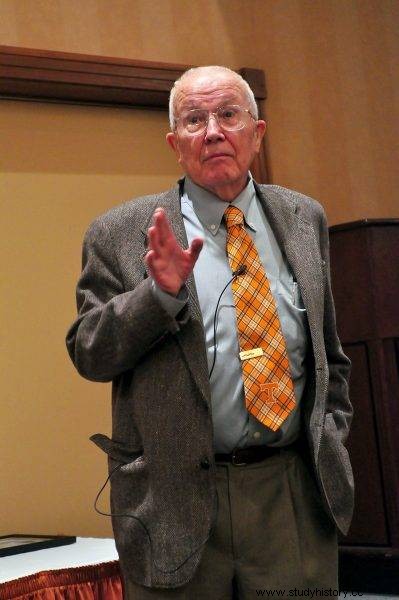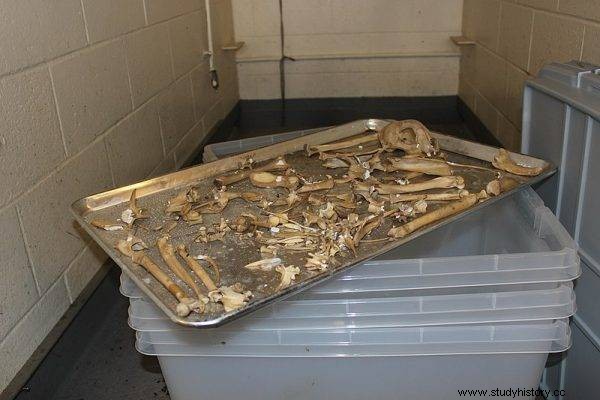In these places, decomposing bodies lie on the ground under the watchful eye of forensic scientists. These are the most gruesome research facilities in the world.
Despite the drastic nature of the research conducted here, the concept of the corpse farm has proved to be very helpful in gaining knowledge in forensics and related sciences. Thanks to the idea of Dr. William Bass of the University of Tennessee , the world has learned a great deal about what happens to our bodies after death, how decay proceeds under various conditions and how the found cadavers can be identified.
How long does it take to get the larva?
Born in 1928 in the American town of Staunton, William Bass was educated at the University of Virginia and later the University of Kentucky. He graduated from the University of Pennsylvania in 1961. Initially, he was involved in the study of the graves of the indigenous people of America. The work - quite controversial in the eyes of modern Indians - and the tragic death of his first two wives from cancer contributed to the formation of a rather specific approach to death in the mind of a scholar.
As early as 1971, Dr. Bill Bass became head of the anthropology department at Tennessee Medical University. The police often approached him with questions related to the found bodies . In those days, was not asked to try to identify the body . Science has not yet allowed anthropologists, for example, to reliably recreate an image. Rather, it was asked how long a given body had been in a given place before it was found.

Bill Bass, creator of the first corpse farm
It so happened that the first few cases that hit the Bass table were bodies full of insect larvae . The scientist searched the specialist literature for information about the time after which the maggots began to appear on the rotting flesh and… found nothing. It's just that no one has thought about it before! This pushed Bass to take decisive steps.
Read also:Murder of the Lyon sisters. Investigation into one of America's greatest criminal mysteries
Where can I put this body?
Back in November of the same year, Bass went to the Dean and said:" Dean, I need a place where I can leave the bodies ” . Of course, to put it simply. The dean agreed to allow Bass to research. Already in 1972 the first experimental site was set up , located in an old sawmill shed where the corpse was allowed to decompose spontaneously and the process was observed.
The project was developing dynamically. In 1980, Bass had to arrange more land , located closer to the university. It just so happened that the Environmental Protection Agency recently banned incineration of garbage in a nearby landfill. The place was covered with earth and placed under the care of a scientist. This is how the University of Tennessee Department of Anthropology Research Institution was founded in which observations of decomposing corpses were made.

Already in 1972, the first experimental site was established, in which the corpse was allowed to decompose itself
Currently a dedicated area of 10,000 m 2 surrounded by a fence and barbed wire, takes about 100 bodies a year . They are put in various places and positions in order to observe the decomposition process under various conditions. For example, research is carried out on the decomposition of the body in a car trunk, under water or in a caravan. The observations mainly concern the sequence and rate of degradation, as well as the activity of insects and related symptoms.
Also read:Corpses to be eaten by vultures and ... dogs. This religion dealt extremely brutally with the dead
Dead Farm Fashion
The Dead Farm in Tennessee is obviously not the only one of its kind. Other universities, not only in the USA, also followed in the footsteps of Dr. Bass's project. Within the United States alone, such sites are already found in West Carolina, Texas (two locations), Southern Illinois, Colorado, and South Florida.
The first research site in Australia was not opened until 2016. It was also the first facility outside the US. Its creation was very necessary because the results of the observations carried out in the USA did not correlate with those observed by the Australian forensics community. Climate is of great importance to the decomposition of cadavers. The Australian Corpse Farm is now located on the outskirts of Sydney, near Yarramundi. On the basis of the observations made here, it was possible to determine, among other things, that the hands of dead people move much more during decomposition than previously thought . The cause is most likely contracting and shortening ligaments.
There are plans to establish a second farm in Australia, this time in central Queensland. It would be the first of its kind in a tropical climate.

Roma Khan from India is monitoring the distribution of carcasses on cows
The first farm in Canada was established in 2018. There are no officially operating research facilities of this type in Europe, Asia and South America, although scientists are observing decaying animals (Roma Khan from India on cows, and Professor Sue Black in Great Britain on pigs).
Dead Man in sight
There is, of course, some controversy about the activities of the scientists on the dead farms. Local communities in the US have protested more than once against the disturbing nature of the research. There have been complaints about odor, possible contamination of groundwater and the terrifying sight of a decomposing corpse. In the United States, most of these protests eventually faded away or was softened. For example, Tennessee has a high fence that makes it impossible to see the body from the outside. It turned out to be a sufficient preventive measure. As the founder of the first farm himself said in an interview for the magazine "Vice" in 2009:
" So many things happen to people after death that we rejected, actually saying," You can't look at it. " But in my opinion, people are wondering what's going on behind these closed doors. I don't understand why we're trying to cover it up. Of course, there are cases where you shouldn't let everyone see what happened . I don't think key evidence should be exposed, but at the same time, I don't see any reason why we shouldn't investigate in depth what happens to us after death ”.
Read also:In search of traces of crimes - investigative techniques that changed the way of investigations
Mine of Knowledge
It is impossible not to notice the contribution to science brought by the corpse of the farms. First of all, helped a lot in more precisely determining the time of death, the influence of climate and clothing whether the presence or absence of water at the site where the carcass was left on the rate of decomposition.
Microbiology has also made progress: successfully identified the impact of decaying cadavers and their microbiome on the local environment. And vice versa - the influence of local communities of microorganisms on the body. Micro-scientist Jennifer DeBruyn discovered that some Lactobacillus bacteria and Bacteroides have so regular cycles and numbers in decomposing cadavers that it may be possible to even more accurately determine the time of death with their help. And this despite the effects of climate, water and the number of scavengers.

Trouble Farms Revolutionize Forensics
It has been possible to observe a number of interesting phenomena related to rotting bodies. For example, t es that rest in the air “move” due to animal activity much more than previously thought. Previously, this could lead to misperceptions at the crime scene.
After decomposing, the surrounding vegetation temporarily freezes and a darker trail is visible on the ground. After some time, the plants return to this place and grow more abundantly than their neighbors. This, however, is not always a good guide to start your search. They could turn out to be too time-consuming and uncertain. Therefore, scientists, using data from corpse farms, characterized more than 500 chemical compounds unique to decaying bodies . They can be detected with a special chemoreceptor "sniffer", even when the body is underground.
Read also:The ideal medicine, or about the beneficial properties of the corpses of convicts
Guess Who
On a dead man's farm in Pasco County, Florida, laser mapping technologies are also being tested both from ground level and from the air. This allows for the creation of a digital model of the place where the body was found. Research is also carried out on the isotopes of the elements that make up the bodies. Oxygen isotopes embedded in the teeth can be an indication of where a person grew up, where they lived. Heavier isotopes are more common in southern South America. As you move north, their number will decrease. Knowing the characteristics of the water occurring in a given region, it is possible to approximate the place of birth of the deceased person. And this regardless of whether the investigation is taking place in America or on another continent.
In addition to timing of death, troupe farms also help in identifying bodies found. Based on the remains of the corpse farms, facial reconstruction models are built based on the skull of the deceased, which can help a lot in determining who we are dealing with.
University of South Florida crime anthropologist Erin Kimberly spoke in an interview with Vice magazine about 250,000 unsolved murders committed in the US since 1980 (data for 2019). It is estimated that in the US alone, there are currently approximately 50,000 unidentified cadavers rested in morgues . Lots of things go to a standstill, and bodies that are found are never identified. That is why, with the help of the dead farms, training in the field of forensics is conducted, as well as research on how to obtain as much information as possible about the corpse.
All bodies used in research on corpse farms are found on them either at the premortal will of the owners or after being donated by the families of the deceased.
Bibliography:
- Montgomery, D., William Bass wants your body . Washington Post, 1999.
- Lambert, A., Body Farm . Vice, vol. 16, issue 2, 2009.
- The Farm of Rotting Corpses in Tennessee . VBS IPTV, LLC., 2009. Accessed May 6, 2022.
